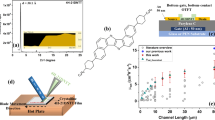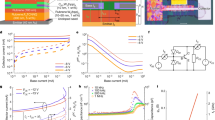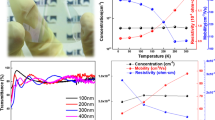Abstract
High-performance thin-film transistors (TFTs) that can be fabricated at low temperature and are mechanically flexible, optically transparent and compatible with diverse substrate materials are of great current interest. To function at low biases to minimize power consumption, such devices must also contain a high-mobility semiconductor and/or a high-capacitance gate dielectric. Here we report transparent inorganic–organic hybrid n-type TFTs fabricated at room temperature by combining In2O3 thin films grown by ion-assisted deposition, with nanoscale organic dielectrics self-assembled in a solution-phase process. Such TFTs combine the advantages of a high-mobility transparent inorganic semiconductor with an ultrathin high-capacitance/low-leakage organic gate dielectric. The resulting, completely transparent TFTs exhibit excellent operating characteristics near 1.0 V with large field-effect mobilities of >120 cm2 V−1 s−1, drain–source current on/off modulation ratio (Ion/Ioff)∼105, near-zero threshold voltages and sub-threshold gate voltage swings of 90 mV per decade. The results suggest new strategies for achieving ‘invisible’ optoelectronics.
This is a preview of subscription content, access via your institution
Access options
Subscribe to this journal
Receive 12 print issues and online access
$259.00 per year
only $21.58 per issue
Buy this article
- Purchase on Springer Link
- Instant access to full article PDF
Prices may be subject to local taxes which are calculated during checkout





Similar content being viewed by others
References
Kagan, C. R. & Andry, P. Thin-Film Transistors (Marcel Dekker, New York, 2003).
Facchetti, A., Yoon, M. H. & Marks, T. J. Gate dielectrics for organic field-effect transistors: New opportunities for organic electronics. Adv. Mater. 17, 1705–1725 (2005).
Nomura, K. et al. Room-temperature fabrication of transparent flexible thin-film transistors using amorphous oxide semiconductors. Nature 432, 488–492 (2004).
Wager, J. F. Transparent electronics. Science 300, 1245–1246 (2003).
Chang, Y.-J. et al. Growth, characterization and application of CdS thin films deposited by chemical bath deposition. Surf. Interface Anal. 37, 398–405 (2005).
Gan, F. Y. & Shih, I. Preparation of thin-film transistors with chemical bath deposited CdSe and CdS thin films. IEEE Trans. Electron Device 49, 15–18 (2002).
Kobayashi, S. et al. Optical and electrical properties of amorphous and microcrystalline GaN films and their application to transparent TFT. Appl. Surf. Sci. 113–114, 480–484 (1997).
Landheer, D. et al. Back-surface passivation of polycrystalline CdSe thin-film transistors. J. Vac. Sci. Technol. A 16, 834–837 (1998).
Masson, D. P., Landheer, D., Quance, T. & Hulse, J. E. Bonding at the CdSe/SiOx (x=0,1,2) interfaces. J. Appl. Phys. 84, 4911–4920 (1998).
Long, K. et al. Stability of amorphous-silicon TFTs deposited on clear plastic substrates at 250 ∘C to 280 ∘C. IEEE Electron Device Lett. 27, 111–113 (2006).
Van der Wilt, P. C. et al. Low-temperature polycrystalline silicon thin-film transistors and circuits on flexible substrates. Mater. Res. Soc. Bull. 31, 461–465 (2006).
Sazonov, A., Meitine, M., Stryakhilev, D. & Nathan, A. Low-temperature materials and thin-film transistors for electronics on flexible substrates. Semiconductors 40, 959–967 (2006).
Cheng, I.-C., Kattamis, A. Z., Long, K., Sturm, J. C. & Wagner, S. Self-aligned amorphous-silicon TFTs on clear plastic substrates. IEEE Electron Device Lett. 27, 166–168 (2006).
Bonse, M., Thomasson, D. B., Klauk, H., Gundlach, D. J. & Jackson, T. N. Integrated a-Si:H/pentacene inorganic/organic complementary circuits. Technical Digest—International Electron Devices Meeting 249–252 (1998).
Wong, W. S., Lujan, R., Daniel, J. H. & Limb, S. Digital lithography for large-area electronics on flexible substrates. J. Non-Cryst. Solids 352, 1981–1985 (2006).
Lee, S.-H. et al. Amorphous silicon film deposition by low temperature catalytic chemical vapor deposition (<150∘C) and laser crystallization for polycrystalline silicon thin-film transistor application. Jpn J. Appl. Phys. 2 45, L227–L229 (2006).
Cao, Q. et al. Transparent flexible organic thin-film transistors that use printed single-walled carbon nanotube electrodes. Appl. Phys. Lett. 88, 113511 (2006).
Chua, L.-L. et al. General observation of n-type field-effect behaviour in organic semiconductors. Nature 434, 194–199 (2005).
Cicoira, F. et al. Correlation between morphology and field-effect-transistor mobility in tetracene thin films. Adv. Funct. Mater. 15, 375–380 (2005).
Facchetti, A., Yoon, M. H., Stern, C. L., Katz, H. E. & Marks, T. J. Building blocks for n-type organic electronics: Regiochemically modulated inversion of majority carrier sign in perfluoroarene-modified polythiophene semiconductors. Angew. Chem. Int. Edn Engl. 42, 3900–3903 (2003).
Katz, H. E. Recent advances in semiconductor performance and printing processes for organic transistor-based electronics. Chem. Mater. 16, 4748–4756 (2004).
Majewski, L. A., Schroeder, R. & Grell, M. One volt organic transistor. Adv. Mater. 17, 192–196 (2005).
Dehuff, N. L. et al. Transparent thin-film transistors with zinc indium oxide channel layer. J. Appl. Phys. 97, 064505 (2005).
Chiang, H. Q., Wager, J. F., Hoffman, R. L., Jeong, J. & Keszler, D. A. High mobility transparent thin-film transistors with amorphous zinc tin oxide channel layer. Appl. Phys. Lett. 86, 013503 (2005).
Presley, R. E. et al. Tin oxide transparent thin-film transistors. J. Phys. D 37, 2810–2813 (2004).
Kwon, Y. et al. Enhancement-mode thin-film field-effect transistor using phosphorus-doped (Zn, Mg)O channel. Appl. Phys. Lett. 84, 2685–2687 (2004).
Hoffman, R. L., Norris, B. J. & Wager, J. F. ZnO-based transparent thin-film transistors. Appl. Phys. Lett. 82, 733–735 (2003).
Nomura, K. et al. Thin-film transistor fabricated in single-crystalline transparent oxide semiconductor. Science 300, 1269–1272 (2003).
Fortunato, E. M. C. et al. Fully transparent ZnO thin-film transistor produced at room temperature. Adv. Mater. 17, 590–594 (2005).
Radha Krishna, B., Subramanyam, T. K., Srinivasulu Naidu, B. & Uthanna, S. Effect of substrate temperature on the electrical and optical properties of dc reactive magnetron sputtered indium oxide films. Opt. Mater. 15, 217–224 (2000).
Weiher, R. L. & Ley, R. P. Optical properties of indium oxide. J. Appl. Phys. 37, 299–302 (1966).
Weiher, R. L. Electrical properties of single crystals of indium oxide. J. Appl. Phys. 33, 2834–2839 (1962).
Wang, L., Yang, Y., Marks, T. J., Liu, Z. & Ho, S.-T. Near-infrared transparent electrodes for precision Teng-Man electro-optic measurements: In2O3 thin-film electrodes with tunable near-infrared transparency. Appl. Phys. Lett. 87, 161107 (2005).
Yoon, M. H., Facchetti, A. & Marks, T. J. σ–π molecular dielectric multilayers for low-voltage organic thin-film transistors. Proc. Natl Acad. Sci. USA 102, 4678–4682 (2005).
Yoon, M. H., Yan, H., Facchetti, A. & Marks, T. J. Low-voltage organic field-effect transistors and inverters enabled by ultrathin cross-linked polymers as gate dielectrics. J. Am. Chem. Soc. 127, 10388–10395 (2005).
Xu, G. et al. Organic electro-optic modulator using transparent conducting oxides as electrodes. Opt. Express 13, 7380–7385 (2005).
Yang, Y. et al. High-performance organic light-emitting diodes using ITO anodes grown on plastic by room-temperature ion-assisted deposition. Adv. Mater. 16, 321–324 (2004).
Bao, Z., Kuck, V., Rogers, J. A. & Paczkowski, M. A. Silsesquioxane resins as high-performance solution processible dielectric materials for organic transistor applications. Adv. Funct. Mater. 12, 526–531 (2002).
Standard Test Methods for Measuring Adhesion by Tape Test (D3359-02, ASTM International, 2002).
Charbonnier, M., Romand, M., Goepfert, Y., Leonard, D. & Bouadi, M. Copper metallization of polymers by a palladium-free electroless process. Surf. Coat. Technol. 200, 5478–5486 (2006).
Garza, M., Liu, J., Magtoto, N. P. & Kelber, J. A. Adhesion behavior of electroless deposited Cu on Pt/Ta silicate and Pt/SiO2 . Surf. Coat. Technol. 222, 253–262 (2004).
Metz, A. W. et al. Transparent conducting oxides: Texture and microstructure effects on charge carrier mobility in MOCVD-derived CdO thin films grown with a thermally stable, low-melting precursor. J. Am. Chem. Soc. 126, 8477–8492 (2004).
Wang, L., Yang, Y., Jin, S. & Marks, T. J. MgO(100) template layer for CdO thin film growth: Strategies to enhance microstructural crystallinity and charge carrier mobility. Appl. Phys. Lett. 88, 162115.
Taga, N., Shigesato, Y. & Kamei, M. Electrical properties and surface morphology of heteroepitaxial-grown tin-doped indium oxide thin films deposited by molecular-beam epitaxy. J. Vac. Sci. Technol. A 18, 1663–1667 (2000).
Colinge, J. P. Subthreshold slope of thin-film SOI MOSFET’s. IEEE Electron Device Lett. 7, 244–246 (1986).
Levinson, J. et al. Conductivity behavior in polycrystalline semiconductor thin film transistors. J. Appl. Phys. 53, 1193–1202 (1982).
Acknowledgements
We thank the NASA Institute for Nanoelectronics and Computing (NCC2-3163) and DARPA/ARO (W911NF-05-1-0187) for support of this research. Characterization facilities were provided by the Northwestern University MRSEC (NSF-DMR-00760097).
Author information
Authors and Affiliations
Corresponding author
Ethics declarations
Competing interests
The authors declare no competing financial interests.
Supplementary information
Supplementary Information
Supplementary figures S1-S4 (PDF 218 kb)
Rights and permissions
About this article
Cite this article
Wang, L., Yoon, MH., Lu, G. et al. High-performance transparent inorganic–organic hybrid thin-film n-type transistors. Nature Mater 5, 893–900 (2006). https://doi.org/10.1038/nmat1755
Received:
Accepted:
Published:
Issue Date:
DOI: https://doi.org/10.1038/nmat1755
This article is cited by
-
High-mobility p-type semiconducting two-dimensional β-TeO2
Nature Electronics (2021)
-
Sol-gel-derived transparent metal oxide flexible field effect transistors
Environmental Science and Pollution Research (2021)
-
Effects of Unusual Gate Current on the Electrical Properties of Oxide Thin-Film Transistors
Scientific Reports (2018)
-
Lead-free Single-molecule Switching Material with Electric, Optical, Thermal Triple Controllable Multifunction Based on Perovskite-like Crystal and Flexible Thin Film
Scientific Reports (2017)
-
Achieving high carrier mobility exceeding 70 cm2/Vs in amorphous zinc tin oxide thin-film transistors
Electronic Materials Letters (2017)



